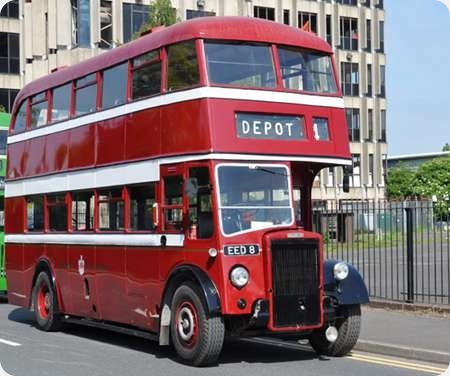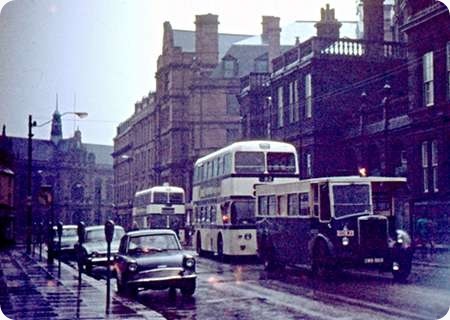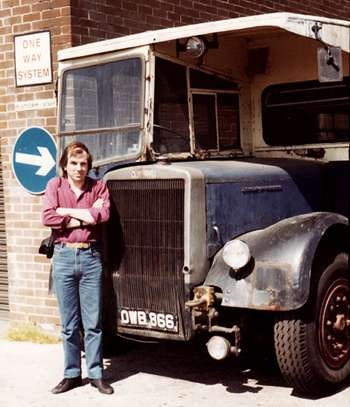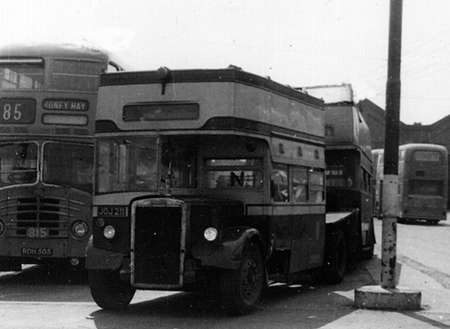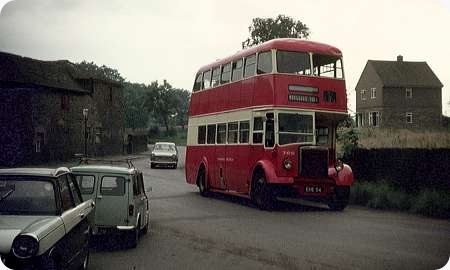Warrington Corporation – Leyland Titan – EED 8 – 24
Warrington Corporation
1947
Leyland Titan PD1
Leyland H30/26R
EED 8 is a Leyland Titan PD1 and according to others on the web it is said to have a Leyland/Alexander H56R body new in 1947 to Warrington as their number 24. Maybe Leyland were busy at the time and it was a Leyland body assembled by Alexander.
It is at present owned by NWVRT and they have repainted it recently into Warrington colours. It was one of three half cabs in service during their 2014 rally at Kirkby.
Photograph and Copy contributed by Ken Jones
06/10/14 – 07:05
How close to a Leyland body is that?
Jim Hepburn
06/10/14 – 07:06
Alexanders built numerous bodies under sub-contract to Leyland – although the detailing on the Ribble Titans betrayed their non-Leyland credentials. I seem to remember reading that there was at least one other sub-contractor (Santus?) – and was SMT involved in this as well? SMT certainly built their own "Duple Vista" bodies on Bedford OBs which were virtually indistinguishable. Alexanders certainly built a "Leyland" body on a PD2 prototype.
David Oldfield
06/10/14 – 09:10
David, in a similar manner to the Alexander sub contract PD1s were also bodied by Samlesbury Engineering in Lancashire.
Chris Youhill
06/10/14 – 10:02
Thanks, Chris. I think maybe that it was Samlesbury that I had in no.
David Oldfield
06/10/14 – 10:02
Warrington 24 (EED 8) has been in preservation for many years in Warrington colours, and has indeed been subject to a recent repaint. Although, as has been said, the body was indeed built by Alexander, it is still ‘officially’ a Leyland body, and has always been described as such, in the same fashion as East Lancs bodies built by Bruce and later Neepsend were initially described as East Lancs products, although latterly Bruce and Neepsend have been used to describe them, so Leyland or maybe Alexander, but please not Leyland/Alexander!
Philip Lamb
06/10/14 – 13:54
…..and, of course, there is the long Alexander tradition of building other’s designs – sometimes under subcontract, sometimes not. (Glasgow’s "Weymann" bodies). This was replied to by the likes of East Lands and their R type clones!
David Oldfield
06/10/14 – 13:55
These Alexander-built bodies (the ones for Warrington at least) had a single window in their upper rear emergency exit – as opposed to Leyland’s more usual two – making the back end tend to resemble the prewar Leyland body. It is just discernible in this view. The other distinguishing feature was that normally they had four small sets of ventilation slots along the top of the cab door, unlike the standard Leyland product which had just two horizontal ones, one above the other. However the one pictured has the latter, so I presume must have acquired a secondhand door from a Leyland body at some point during its restoration.
John Stringer
17/02/15 – 15:13
Can some help me, I worked for Walsall Corporation Transport in the early 60s I remember Walsall buying 2 Warrington buses, I think they were
EED 8/9 is this correct?
Bruce Johnson
18/02/15 – 06:42
Bruce J, I’m afraid that I can’t personally answer your question, but I wondered if you could yourself answer a query which has gone round a few websites without being satisfactorily answered. It concerns Walsall’s lightweight Leyland PD2, 823 (TDH 770). I have seen it referred to as being ‘semi-automatic’ but I wonder if you could say if it
1) was a preselect, like the ex-London RTLs;
2) had a direct air system, such as became normal on two-pedal Leyland PD2s, PD3s, Tiger Cubs and Leopards;
3) had an electric gear selector, such as on early Atlanteans, Fleetlines, etc.
If you fail to get a response to your own query here, can I suggest that you try the message board at the sct61 site, it’s always a good place to have questions answered.
David Call
18/02/15 – 08:31
I think Walsall bought a couple of East Lancs bodied PD1s from Warrington , about the same time as the RTLs.
Steve Milner
19/02/15 – 15:55
The two Warrington Corporation Titans sold to Walsall Corporation were 100/01 (EED 9/10).
They were Titan PD1A with Bruce L27/26R new in 1947 and sold to Walsall in July 1959 as numbers 198/99, lasting until being sold for scrap in 1963 and 1964 respectively.
They were Warrington Corporation’s only two lowbridge buses.
Dave Farrier
12/03/15 – 06:44
I have been the owner of ex-Warrington PD1 EED 5 (fleet no.24) for nearly 40 years! Like EED 8, it has bodywork designed and produced by Leyland but assembled by Alexander – I have a copy of the letter from Warrington confirming this. The body on EED 5 is original and classed as a Leyland metal framed type: this has a cab door with four vents near the top and rear emergency door on the top deck containing two windows.
Phil Clark
12/03/15 – 17:03
In distinguishing between the Leyland and Alexander product on the PD1 chassis I have always used the style of the front panel of the cab as the determining feature. On the Leyland body it always conceals the mudguard, usually with the horn inserted as on the Warrington bus. The Alexander version has a shorter and slightly more set back panel allowing the bottom of the mudguard to protrude, as can be seen in the attached picture. This actually shows both PD1 (right) and PD2/1 (left) versions of the ‘pure’ Alexander product.
There are also variations in the shape of the nearside canopy. The Leyland style on the Warrington PD1 is a continuous curve from top front corner to where it meets the mudguard, projecting in front of the bulkhead. This is echoed on the Alexander PD2, but on the PD1 it goes straight back from the front corner with quite a short valance with a basically angled profile. There is no projection of the side panel in front of the bulkhead.
A further question is whether Alexander actually produced a highbridge version of the Leyland clone (as opposed to assembling Leyland parts). There are certainly none that I can locate in any of the SBG fleets, although they might have delivered to other fleets. Nothing at this period was supplied to any of the Scottish municipal fleets.
Alan Murray-Rust
13/03/15 – 07:10
The photo of CRG and AWG also seems to show 2 other diagnostic differences. The gap between the 2 blind boxes and the design of the top of the upper deck front windows.
John Lomas
13/03/15 – 12:49
The points you mention are diagnostic between the versions of the Alexander body; I was aiming to highlight the differences between the Leyland and Alexander products.
Alan Murray-Rust
05/05/15 – 07:23
I’ve seen EED 8 mentioned on here and just to let you know it’s back in Warrington and privately owned I’m trying to set up a page on Facebook for my husband it his is bus.
Trina
03/03/18 – 06:47
I am sorry to inform you that EED 8, which was preserved in Warrington, was destroyed in a fire on Thursday 1st March 2018. A sad loss.
Paul Mason
03/03/18 – 06:50
Sad to say Warrington Corporation no 8 EED 8 is no more, destroyed in fire at Fairbrothers Bewsey Warrington.
Anthony Mcdonnell
04/03/18 – 06:46
It is unfortunate that it had gone back to Warrington. www.warrington-worldwide.co.uk/
John Lomas
29/03/18 – 06:02
It was very sad to see the destruction of EED 8 by fire, a tragic accident that has destroyed all but the chassis, running gear, cab and the front, but it was remarkable to see the engine start and run straight away so that it could be driven out of the shed. I wish Ray and colleagues every good wish in their desire to rebuild the vehicle and hope that one day we can re-unite EED 8 with my bus EED 5.
Phil Clark
30/03/18 – 07:53
How sad, Phil. What actually happened?
Chris Hebbron
02/04/18 – 07:30
I saw the bus on BBC North West news and the vehicle was still recognisable but sadly I think the best thing for EED 8 is to be sold as spares for another Leyland PD1. The only other option, which would effectively mean building a new bus would be to follow the example of WW2 utility Guy Arab CDR 679, which lost its original body but was fitted with another utilitybody, but such matches are rare. I wish the owner well and I’m sorry about the fire.
Paul Mason
Quick links to the - Comments Page - Contact Page - Home Page
